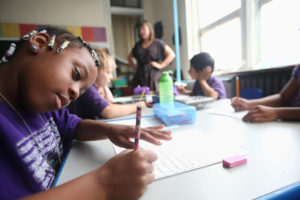Ten years ago, Hurricane Katrina devastated New Orleans, disrupting the lives of thousands of Black families. News reports have stated many Black families never returned for a variety of reasons. Some lacked the funds, others had trouble rebuilding their homes. However, Katrina also affected the lives of thousands of school-age children whose education was interrupted for months.
Katrina provided an opportunity for then Gov. Kathleen Blanco to radically reform the troubled public school system. Even before Katrina, the New Orleans public schools had been plagued with problems such as dismal graduation rates, corruption and mismanagement. Blanco reformed the school system by firing more than 7,000 mostly Black, veteran teachers and school staff. They were replaced by young, idealistic, white teachers who were willing to work long hours at lower-paid positions at charter schools. Charter schools, which are publicly-funded private academies, are controversial. While proponents say they are more efficient than public schools, critics say they don’t improve test scores. Also, teachers at charter schools are at-will employees, who make less money and have little job security.
In 2005, the Louisiana board of education turned over 100 underperforming New Orleans schools to the Recovery School District (RSD,) a charter school, leaving only 17 schools under local control. This educational social experiment has had mixed results. Mercedes Schneider, a public school teacher and education activist, said RSDs are not producing students who are ready for college.
“Of the 16 active New Orleans RSD high schools, five graduated not one student meeting the (Louisiana Board of) Regents 18-English-19-math ACT requirement. That’s no qualifying students out of 215 test takers,” Schneider told the Huffington Post. “Another six RSD high schools each graduated less than one percent meeting the requirement, or 16 students out of 274 (5.8 percent).”
Critics of the new charter schools also say they are using harsh disciplinary measures to get rid of troubled students.
“Although New Orleans schools are supposed to be some of the most innovative schools in the country, they are far from it when it comes to discipline. For the last five years, New Orleans has had at least 15 or so schools with suspension rates exceeding an already high statewide average. In fact, a handful of schools have been suspending kids at rates of 40, 50, 60 percent and more each year. These are likely some of the highest suspension rates in the nation,” said Eden Heilman, director of the Lousiana office of the Southern Poverty Law Center, told Louisiana Weekly.
Educators refer to this tactic as “pushout,” where teachers use a variety of means to get problem children out of the school system in the hope of raising test scores.
Heilman also pointed to a disturbing statistic in Jefferson Parish schools. In the 2013-14 school year, Jefferson Parish schools allowed police to make 600 arrests. However, 400 were for non-violent offenses such as “interference with an educational facility, disturbing the peace, or truancy.”
There may be thousands of children who were traumatized by Katrina and are now displaying behavioral problems that make it hard for them to get an education. After having to survive floods, wading through rising water and witnessing a humanitarian disaster at the Superdome, many children had a hard time adjusting to hostile new environments. Devine Lee told The Atlantic his family faced such a violent reaction from people in Houston, that his mom eventually kept her children at home.
“It hurt my mom, us not being in school. At that time, she felt like she’d let us down,” said Lee, who was 13 at the time. “But she was terrified. They were shooting us out there.” A New Orleans transplant was shot dead in Houston.
Black families who were forcibly resettled had a tough time finding their feet. Often faced with little financial resources and no social network, they had a hard time finding work, and often bounced from one relative’s house to another. This lack of stability also caused a major disruption in children’s education.
“I think 90-percent-plus of my students didn’t learn for a year after Katrina,” said Matthew Feigenbaum, a former dean at Renew Accelerated High School, who helps students catch up.
These displaced children are behind New Orleans’ high demand for GED and entry-level job training programs. A report by the Cowen Institute at Tulane University stated that New Orleans had the third highest percentage (18.2 percent) of 16-24 years old who were either unemployed or not in school.


